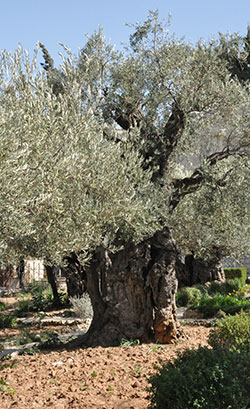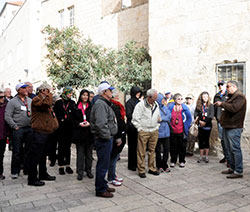By Natalie Hoefer
JERUSALEM—The temperature in Jerusalem has dropped from the warm climate of Galilee.
“Do you feel like the temperature of the pilgrimage changed a little this morning?” Archbishop Joseph W. Tobin asked in his homily at Mass in the Church of All Nations in the Garden of Gethsemane. “And I’m not simply talking about the breezes.
“I refer to what a lot of us were thinking about. In Galilee we were thinking of this young, vigorous Christ, walking, preaching, fasting. Here it begins to change, and we think of him prostrated on a rock like this, praying, with his disciples not far away.”
He said this pointing in front of the altar, where the sanctuary encompasses the rock upon which it is believed Christ wept in agony.
The pilgrims took the Palm Sunday path of Christ down the Mount of Olives—the path along which Scripture speaks of his royal welcome with palm branches by the Jews.
By the end of the week of Christ’s triumphal welcome, the Gospels speak of Christ’s agony in the Garden of Gethsemane, of his arrest, torture and crucifixion.
The pilgrims started living Christ’s sorrowful journey today, visiting the Upper Room of the Last Supper, Mount of Olives, Garden of Gethsemane and house of Caiaphas where Christ was imprisoned over night before being brought before Pontius Pilate. (See a photo gallery from their day)
In the Garden of Gethsemane, today’s Mass was offered for the sick and the dying in the archdiocese, “those who in a real way believe with the eyes of faith and share in the suffering of Christ,” the archbishop said in his homily.
The archbishop encouraged the pilgrims to visit the sick and dying, and to not worry about what to pray. “Our Fathers and Hail Mary’s are OK,” he reassured.
He noted that St. Alphonsus once advised those in the Redemptorist order he founded: “Pray when you are well, because it’s hard to pray when you are sick.”
Suffering can put us in danger of despairing and forgetting the Lord, Archbishop Tobin warned.
“The Lord invites us today to pray—not out of fear or anxiety, but to say, ‘Lord, help me remember that you are always with me, and help me be a living reminder to those who share your own Gethsamane.’ ”
Anne Kuhn of St. Barnabas Parish in Indianapolis was moved by the rock in front of the altar.
“When we had Mass at the Garden, when I went in and was able to touch the rock that he suffered on and agonized over, it brought the whole thing to life,” she said. “As a human, he knew what was going to happen, and how he didn’t want it to happen, but he accepted it. I think, ‘How many times are we like the disciples, letting things slide, and we need to take a stand for what is right and wrong.’ ”
Later the pilgrims visited the Upper Room, reconstructed in early centuries in the area where it is believed the Last Supper took place.
Close by is the Church of St. Peter Gallicantu (“the cock crowed”), constructed over the area where Peter’s denial most likely took place, outside the house of Caiaphas, the high priest who sought Jesus’ arrest and crucifixion.
Tony Azraq, the Catholic Palestinian archaeologist serving as the tour guide for the pilgrims, worked on the excavations that helped reveal much about the house of Caiaphas, including the ways in which prisoners were tortured in the dungeon beneath Caiaphas’ home. He shared with the pilgrims what was discovered about the site, and about what Jesus likely endured between the time of his arrest and sentencing to death.
“[Jesus’ suffering] became more real, especially with the different things they found, even recently, about how they did the torture,” said Mary Barr of St. Andrew the Apostle Parish in Indianapolis. “The archbishop’s talk was so meaningful when he said it’s a different atmosphere we’re coming into today with realizing Jesus’ death coming. Praying for our ill and dying—it all combined. It brought to mind all who are suffering for lack of freedom, not matter what country they’re in.”
Azraq also helped excavate the steps that led to the house of Caiaphas from the Garden of Gethsemane, revealing the actual steps that Christ would have been led by the temple guards after his arrest.
“Looking at the steps that Jesus actually walked” said Sheila Dropcho of Immaculate Heart of Mary Parish in Indianapolis. “I stood and stared at that for a very, very long time, just knowing that [Christ] walked those steps. It was very powerful.”
The pilgrims also visited the Church of the Pater Noster, or the Our Father, on the Mount of Olives, the area in which it is believed Christ taught his disciples how to pray, as described in the Gospels. Around the church and courtyard, the prayer is written in every known language.
“Seeing the Our Father written in so many languages was just amazing,” said Gloria Lieb of St. John Vianney Parish in Fishers in the Diocese of Lafayette in Indiana. “Our guide Tony read the Our Father in Hebrew and in Chaldean, the oldest language. That was so impressive.”
Despite the historical and Scriptural significance of the sites visited today, Dan Conway of SS. Peter and Paul Cathedral in Indianapolis was most touched by the Mass, as he has been each day of the pilgrimage.
“Archbishop Tobin’s homilies are so simple and yet very, very profound,” he said. “Someone said the other day that it’s amazing how, in spite of all the exotic places we are, it’s still the Mass that’s the most important thing.
“The neat thing about coming here to the Holy Land is that these sites and even the geography bring us a new awareness, but it’s an awareness of something that is available every day—you just see it in a new, fresher light.”
See a photo gallery from Day Seven of the pilgrimage


No comments:
Post a Comment